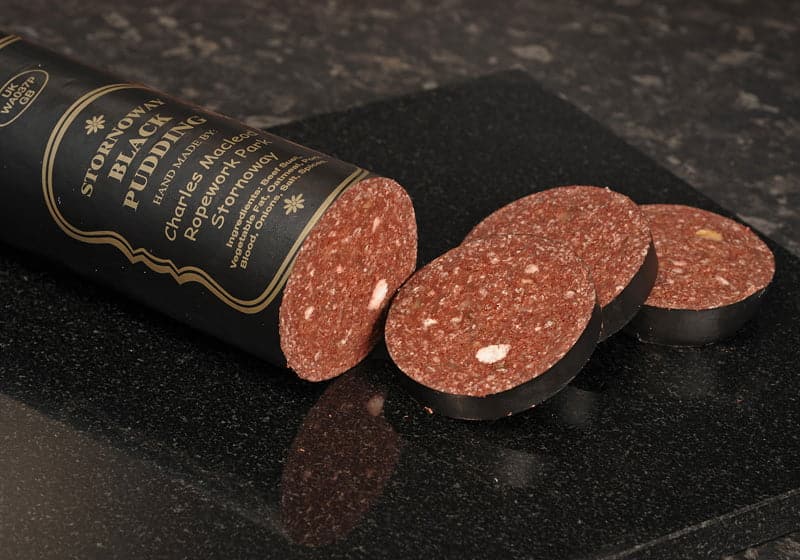During a recent gastronomic trip in Scotland, as I savoured each bite of a full Scottish breakfast complete with crispy tattie scones, haggis and rich, flavoursome black pudding, my mind travelled back to the warm, fragrant kitchens of Spain where morcilla – another variety of blood pudding – is a staple in many regional cuisines. Each, with its unique preparation and ingredients, offers a glimpse into the culinary traditions that have been cherished and nurtured through centuries.

The Origins and Cultural Significance
Scottish Black Pudding
 To uncover the heritage of Scottish black pudding, one must venture to the rugged landscapes of Scotland where this dish holds a place of pride. Thought to have been made by the Celts, this traditional food was a pragmatic way of utilizing every part of the butchered animal. The Scots, known for their thrifty use of ingredients, found that mixing blood with oats and fat could result in a nourishing food source that helped them through the harsh winters.
To uncover the heritage of Scottish black pudding, one must venture to the rugged landscapes of Scotland where this dish holds a place of pride. Thought to have been made by the Celts, this traditional food was a pragmatic way of utilizing every part of the butchered animal. The Scots, known for their thrifty use of ingredients, found that mixing blood with oats and fat could result in a nourishing food source that helped them through the harsh winters.
Not just a breakfast component, in places like Stornoway, black pudding has achieved Protected Geographical Indication (PGI) status, affirming its cultural and historical importance to its place of origin.
Spanish Morcilla
 Across the seas in Spain, morcilla speaks volumes about the diversity of Spanish cuisine. Dating back to the times when the Moors occupied Spain, the variations found across the regions – from Burgos to Andalucía and beyond – underscore the local adaptations and the influence of various cultural dominances over time. In Spain, blood sausages like morcilla were also an ingenious solution to the same problem – using all parts of butchered animals. Morcilla, typically seasoned with onions, rice, or sweet spices, varies not just in flavour but in the philosophy of preparation from region to region.
Across the seas in Spain, morcilla speaks volumes about the diversity of Spanish cuisine. Dating back to the times when the Moors occupied Spain, the variations found across the regions – from Burgos to Andalucía and beyond – underscore the local adaptations and the influence of various cultural dominances over time. In Spain, blood sausages like morcilla were also an ingenious solution to the same problem – using all parts of butchered animals. Morcilla, typically seasoned with onions, rice, or sweet spices, varies not just in flavour but in the philosophy of preparation from region to region.
Ingredients and Preparation
Crafting Scottish Black Pudding
 The primary components of Scottish black pudding are pig's blood, oatmeal, and fat, seasoned with spices such as salt and pepper. The mixture is often stuffed into a casing – traditionally the cleaned intestines of an animal, though nowadays synthetic options are common – and then boiled until it solidifies. The inclusion of oatmeal, a staple in Scotland due to its robustness in the cool, damp Scottish climate, not only thickens the pudding but provides a distinctive texture that is heartier compared to its European cousins.
The primary components of Scottish black pudding are pig's blood, oatmeal, and fat, seasoned with spices such as salt and pepper. The mixture is often stuffed into a casing – traditionally the cleaned intestines of an animal, though nowadays synthetic options are common – and then boiled until it solidifies. The inclusion of oatmeal, a staple in Scotland due to its robustness in the cool, damp Scottish climate, not only thickens the pudding but provides a distinctive texture that is heartier compared to its European cousins.
Creating Spanish Morcilla
 Spanish morcilla might also begin with pork blood, but its secondary ingredients provide the regional flavours that define each type. In Burgos, for example, it is customary to add rice, onions, and sometimes sweet spices like cinnamon or clove, creating a different texture and flavour profile from its Scottish counterpart. Other variations might include almonds, pine nuts, or even orange zest, each contributing to a unique tasting experience. The meticulous preparation and regional ingredient choices such as the use of local onions or specific rice types, cooked in a style befitting its area, highlight the diverse culinary landscape of Spain.
Spanish morcilla might also begin with pork blood, but its secondary ingredients provide the regional flavours that define each type. In Burgos, for example, it is customary to add rice, onions, and sometimes sweet spices like cinnamon or clove, creating a different texture and flavour profile from its Scottish counterpart. Other variations might include almonds, pine nuts, or even orange zest, each contributing to a unique tasting experience. The meticulous preparation and regional ingredient choices such as the use of local onions or specific rice types, cooked in a style befitting its area, highlight the diverse culinary landscape of Spain.
Culinary Uses
From Breakfast to Supper: Scottish Black Pudding
In Scotland, black pudding is traditionally served as part of a hearty breakfast. However, its uses in modern Scottish cuisine have expanded. Chefs are now incorporating black pudding into everything from sophisticated starters to main dishes. It can be crumbled over salads, baked into pies, or even served alongside scallops, demonstrating its versatility.
A Spanish Staple: Morcilla
In Spain, morcilla is similarly versatile. It can be found in stews and casseroles, adding depth and flavour. It is often served fried or grilled as a tapa, with pieces of it cooked until crispy on the outside but still tender inside. In some regions, it's even used as a stuffing in other meats, blending seamlessly with local ingredients to create dishes that are hearty yet distinctively Spanish.
Nutritional Content and Health Considerations
While both black puddings are rich in iron and protein, thanks to their blood content, they are also high in fat and cholesterol. However, the Scottish version, with its significant oat content, offers the added benefit of fibre, which helps in digestion and sustained energy release – essential for the physically demanding lifestyles of its original consumers.
A Tale of Two Puddings
Whether it's the oat-laden, hearty Scottish black pudding or the richly diverse Spanish morcilla, each tells a story of survival, culinary ingenuity, and cultural significance. Tasting them not only offers an insight into the gastronomic histories of Scotland and Spain but also showcases how regional ingredients and traditional methods can craft products that, while similar in concept, are distinctly unique in experience.
My reminiscing about morcilla while eating black pudding in Scotland was more than just a culinary comparison – it was a reflection on how food brings us closer to our roots while letting us appreciate the wider world's flavours. And perhaps, that's the most delicious discovery of all.